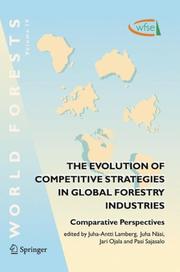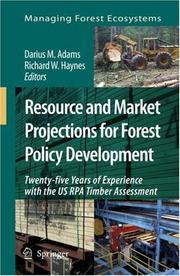| Listing 1 - 10 of 15 | << page >> |
Sort by
|
Book
ISBN: 9282792323 Year: 1996 Volume: *5 Publisher: Luxembourg : Office des publications officielles des communautés européennes = Office for official publications of the European communities = OPOCE,
Abstract | Keywords | Export | Availability | Bookmark
 Loading...
Loading...Choose an application
- Reference Manager
- EndNote
- RefWorks (Direct export to RefWorks)
Industrial economics --- Russian Federation --- Forest products industry --- Economic assistance, European --- Produits forestiers --- Aide économique européenne --- Industrie --- -Forest products industry --- -Forest industries --- Forestry industry --- Wood products industry --- Wood-using industries --- Plant products industry --- International cooperation --- -International cooperation --- Russia --- Aide économique européenne --- Forest industries --- RELATIONS EXTERIEURES --- EUROPE ORIENTALE
Periodical
Abstract | Keywords | Export | Availability | Bookmark
 Loading...
Loading...Choose an application
- Reference Manager
- EndNote
- RefWorks (Direct export to RefWorks)
Lumber trade --- Forest products industry --- Forest products industry. --- Lumber trade. --- wood engineering --- wood processing --- materials science --- wood and timber --- Lumber industry --- Timber industry --- Lumbering --- Forest industries --- Forestry industry --- Wood products industry --- Wood-using industries --- Plant products industry --- Forestry
Periodical
ISSN: 18471153 00126772 Year: 1950 Publisher: Zagreb : Zagreb : Zagreb : Zagreb : Institut za drvo Tehnički centar za drvo Šumarski fakultet Sveučilišta u Zagrebu Fakultet šumarstva i drvne tehnologije, Sveučilišta u Zagrebu
Abstract | Keywords | Export | Availability | Bookmark
 Loading...
Loading...Choose an application
- Reference Manager
- EndNote
- RefWorks (Direct export to RefWorks)
Forest products industry --- Woodworking industries --- Engineering --- Production Technology --- wood technology --- wood materials --- wood production --- wooden products --- trade of wood --- wood machining --- Travail du bois --- Forest products industry. --- Woodworking industries. --- Industrie --- Forest industries --- Forestry industry --- Wood products industry --- Wood-using industries --- Plant products industry
Book
ISBN: 1784023388 1282541684 9786612541681 143777833X 008096446X Year: 2010 Publisher: Norwich, N.Y. : Oxford : William Andrew ; Elsevier Science [distributor],
Abstract | Keywords | Export | Availability | Bookmark
 Loading...
Loading...Choose an application
- Reference Manager
- EndNote
- RefWorks (Direct export to RefWorks)
This new Handbook provides a series of reference guides to cleaner production methods, technologies, and practices for key industry sectors. Each volume covers, for each industry sector: * the manufacturing technologies * waste management * pollution * methods for estimating and reporting emissions * treatment and control technologies * worker and community health risk exposures * cost data for pollution management * cleaner production and prevention alternatives Best Practices in the Wood and Paper Industries provides an overview of the forestry, wood preserving, pulp and paper ind
Best management practices (Pollution prevention) --- Forest products industry --- Paper industry --- Wood-pulp industry --- Environmental aspects. --- Pulp mills --- Paper making and trade --- Papermaking industry --- Non-timber forest products industry --- Forest industries --- Forestry industry --- Wood products industry --- Wood-using industries --- Plant products industry --- BMPs (Pollution prevention) --- Pollution prevention --- Nonpoint source pollution --- Environmental aspects
Periodical
ISSN: 05759536 Year: 1998 Publisher: Ottawa : Statistics Canada = Statistique Canada,
Abstract | Keywords | Export | Availability | Bookmark
 Loading...
Loading...Choose an application
- Reference Manager
- EndNote
- RefWorks (Direct export to RefWorks)
Pulpwood industry --- Forest products industry --- Wood waste --- Forest products industry. --- Pulpwood industry. --- Wood waste. --- Pâte à papier --- Industrie --- Canada. --- Lumber trade --- Forest industries --- Forestry industry --- Wood products industry --- Wood-using industries --- Plant products industry --- Sawdust --- Wood residue --- Waste products --- Wood products --- Canada (Province) --- Canadae --- Ceanada --- Chanada --- Chanadey --- Dominio del Canad --- Dominion of Canada --- Jianada --- Kʻaenada --- Kanada --- Ḳanadah --- Kanadaja --- Kanadas --- Ḳanade --- Kanado --- Kanak --- Province of Canada --- Republica de Canad --- Yn Chanadey --- Dominio del Canadá --- Kaineḍā --- Kanakā --- Republica de Canadá

ISBN: 1559631953 1559631961 Year: 1992 Publisher: Washington Island Press
Abstract | Keywords | Export | Availability | Bookmark
 Loading...
Loading...Choose an application
- Reference Manager
- EndNote
- RefWorks (Direct export to RefWorks)
Forests and forestry --- Forest products --- Forest products industry --- Sustainable forestry --- Forest policy --- Forest ecology --- Forêts et sylviculture --- Produits forestiers --- Foresterie durable --- Politique forestière --- Ecologie forestière --- Industrie --- #ABIB:abos --- Forêts et sylviculture --- Politique forestière --- Ecologie forestière --- Forest land --- Forest lands --- Forest planting --- Forest production --- Forest sciences --- Forestation --- Forested lands --- Forestland --- Forestlands --- Forestry --- Forestry industry --- Forestry sciences --- Land, Forest --- Lands, Forest --- Silviculture --- Sylviculture --- Woodlands --- Woods (Forests) --- Agriculture --- Natural resources --- Afforestation --- Arboriculture --- Logging --- Timber --- Tree crops --- Trees --- Botany, Economic --- Commercial products --- Raw materials --- Forest industries --- Wood products industry --- Wood-using industries --- Plant products industry --- Forest management --- Forest resource policy --- State and forestry --- Economic policy --- Multiple use --- Government policy

ISBN: 0821351702 9786610088348 1280088346 Year: 2002 Publisher: Washington, D.C. : World Bank,
Abstract | Keywords | Export | Availability | Bookmark
 Loading...
Loading...Choose an application
- Reference Manager
- EndNote
- RefWorks (Direct export to RefWorks)
Forestry --- Developing countries --- Subtropical and Tropical Countries --- Forest products --- Forest products industry --- Forests and forestry --- Forest policy --- Revenue --- Business & Economics --- Industries --- Government revenue --- Public revenue --- Forest management --- Forest resource policy --- State and forestry --- Forest land --- Forest lands --- Forest planting --- Forest production --- Forest sciences --- Forestation --- Forested lands --- Forestland --- Forestlands --- Forestry industry --- Forestry sciences --- Land, Forest --- Lands, Forest --- Silviculture --- Sylviculture --- Woodlands --- Woods (Forests) --- Forest industries --- Wood products industry --- Wood-using industries --- Prices --- Licenses --- Government policy --- Economic aspects --- Finance, Public --- Taxation --- Economic policy --- Agriculture --- Natural resources --- Afforestation --- Arboriculture --- Logging --- Timber --- Tree crops --- Trees --- Plant products industry --- Botany, Economic --- Commercial products --- Raw materials

ISSN: 07858388 ISBN: 1280624663 9786610624669 1402040164 1402040156 1402065671 Year: 2006 Volume: v. 4 Publisher: Dordrecht : Springer Netherlands : Imprint: Springer,
Abstract | Keywords | Export | Availability | Bookmark
 Loading...
Loading...Choose an application
- Reference Manager
- EndNote
- RefWorks (Direct export to RefWorks)
This book presents an analysis of the evolution of competitive strategies within the forestry industry. Although the discussion takes place in a relatively narrow field of business on the global scale, the argument is that the chosen context serves as an illustrative setting for a discussion related to global corporate evolution of firms since the industry studied has only recently entered a stage of development characterized by intensified global competition. Moreover, the global forestry industry provides also an ideal setting for the analysis of the changing dynamics of competition within an industry. We propose that the development within the studied industry serves as a symptomatic illustration of the ongoing development processes in other industries: from a competitive setting characterized by a number of small competitors to one dominated by few large equally strong competitors aiming for a global presence. The implications of the study are not restricted to the forestry industry context alone. They extend to other manufacturing industries displaying similar features to the industry studied: maturity, commodity nature, fragmented industry structure, lack of industry leader, and ongoing concentration process. Thus, our contention is that this book contributes to better understanding of the workings of a number of manufacturing industries through discussion of the evolutionary development within the pulp and paper industry.
Forest products industry --- Competition. --- Management. --- Competition --- Competition (Economics) --- Competitiveness (Economics) --- Economic competition --- Commerce --- Conglomerate corporations --- Covenants not to compete --- Industrial concentration --- Monopolies --- Open price system --- Supply and demand --- Trusts, Industrial --- Forest industries --- Forestry industry --- Wood products industry --- Wood-using industries --- Plant products industry --- Economic aspects --- Agricultural economics. --- Forests and forestry. --- History. --- Business. --- Industrial organization. --- Agricultural Economics. --- Forestry. --- History, general. --- Business and Management, general. --- Industrial Organization. --- Industries --- Organization --- Industrial management --- Industrial sociology --- Trade --- Economics --- Management --- Annals --- Auxiliary sciences of history --- Forest land --- Forest lands --- Forest planting --- Forest production --- Forest sciences --- Forestation --- Forested lands --- Forestland --- Forestlands --- Forestry --- Forestry sciences --- Land, Forest --- Lands, Forest --- Silviculture --- Sylviculture --- Woodlands --- Woods (Forests) --- Agriculture --- Natural resources --- Afforestation --- Arboriculture --- Logging --- Timber --- Tree crops --- Trees --- Agrarian question --- Agribusiness --- Agricultural economics --- Agricultural production economics --- Production economics, Agricultural --- Land use, Rural --- Management science. --- Quantitative business analysis --- Problem solving --- Operations research --- Statistical decision

ISBN: 1281339202 9786611339203 1402063091 1402063083 9048176034 Year: 2007 Volume: v. 14 Publisher: Dordrecht : Springer Netherlands : Imprint: Springer,
Abstract | Keywords | Export | Availability | Bookmark
 Loading...
Loading...Choose an application
- Reference Manager
- EndNote
- RefWorks (Direct export to RefWorks)
Long-range models that include product and resource detail are essential to meaningful analysis of both industry and resource sustainability. Taking this as it’s central argument, this book provides essential reading to anyone interested in projecting the future of either the forest products market and/or the forest resource conditions. It is aimed at policy makers, model builders, researchers and graduate students who are building or using forest sector models, as well as at forest industry managers and analysts. While focusing on a specific modeling system – the US Timber Assessment models – the authors highlight the general elements that might comprise a forest-sector market model of any country or region. Approaches to policy analysis are also general and equally applicable to both national and multi-national forest policy development outside the US – particularly in relation to on-going efforts to formulate national programs of sustainable forestry. The text provides literature surveys on relevant modeling issues and policy concerns, and demonstrates the application of the modeling system using a "base case" 50 year projection and a small set of scenarios to illustrate, for example, the effects of changes in public harvest policies, global change, variations in investments in silviculture, and globalization. Darius Adams and Richard Haynes are widely recognized as leading experts in the forest sector modeling field.
Forest policy --- Forest products industry --- Forests and forestry --- Logging --- Timber --- Forecasting. --- Forecasting --- Mathematical models. --- Forest production --- Building materials --- Forest products --- Lumber trade --- Lumber --- Tree farms --- Trees --- Wood --- Forest harvesting --- Pulpwood --- Harvesting --- Lumbering --- Forestry engineering --- Forest land --- Forest lands --- Forest planting --- Forest sciences --- Forestation --- Forested lands --- Forestland --- Forestlands --- Forestry --- Forestry industry --- Forestry sciences --- Land, Forest --- Lands, Forest --- Silviculture --- Sylviculture --- Woodlands --- Woods (Forests) --- Agriculture --- Natural resources --- Afforestation --- Arboriculture --- Tree crops --- Forest industries --- Wood products industry --- Wood-using industries --- Plant products industry --- Forests and forestry. --- Environmental management. --- Business. --- Environmental law. --- Forestry. --- Environmental Management. --- Business and Management, general. --- Environmental Law/Policy/Ecojustice. --- Environment law --- Environmental control --- Environmental protection --- Environmental quality --- Environmental policy --- Law --- Sustainable development --- Trade --- Economics --- Management --- Commerce --- Industrial management --- Environmental stewardship --- Stewardship, Environmental --- Environmental sciences --- Law and legislation --- Management science. --- Environmental policy. --- Environment and state --- Environmental management --- State and environment --- Environmental auditing --- Quantitative business analysis --- Problem solving --- Operations research --- Statistical decision --- Government policy
Book
ISBN: 3642108148 364210813X 9783642108136 Year: 2014 Publisher: Berlin, Heidelberg : Springer Berlin Heidelberg : Imprint: Springer,
Abstract | Keywords | Export | Availability | Bookmark
 Loading...
Loading...Choose an application
- Reference Manager
- EndNote
- RefWorks (Direct export to RefWorks)
The book is an essential reference source on reaction wood for wood scientists and technologists, plant biologists, silviculturists, forest ecologists, and anyone involved in the growing of trees and the processing of wood. It brings together our current understanding of all aspects of reaction wood, and is the first book to compare and discuss both compression wood and tension wood. Trees produce reaction wood to maintain the vertical orientation of their stems and the optimum angle of each branch. They achieve this by laying down fibre cell walls in which differences in physical and chemical structure from those of normal fibres are expressed as differential stresses across the stem or branch. This process, while of obvious value for the survival of the tree, causes serious problems for the utilisation of timber. Timber derived from trees containing significant amounts of reaction wood is subject to dimensional instability on drying, causing distortion and splitting. It is also difficult to work as timber, and for the pulp and paper industry the cost of removing the increased amount of lignin in compression wood is substantial. This has both practical and economic consequences for industry. Understanding the factors controlling reaction wood formation and its effect on wood structure is therefore fundamental to our understanding of the adaptation of trees to their environment and to the sustainable use of wood. The topics covered include: -Morphology, anatomy and ultrastructure of reaction wood -Cell-wall polymers in reaction wood and their biosynthesis -Changes in tree proteomes during reaction wood formation <-The biomechanical action and biological functions of reaction wood - Physical and mechanical properties of reaction wood from the scale of cell walls to planks -The detection and characterisation of compression wood -Effects of reaction wood on the performance of wood and wood-based products - Commercial implications of reaction wood and the influence of forest management on its formation.
Trees. --- Forests and forestry. --- Forest products industry. --- Forest industries --- Forestry industry --- Wood products industry --- Wood-using industries --- Plant products industry --- Forest land --- Forest lands --- Forest planting --- Forest production --- Forest sciences --- Forestation --- Forested lands --- Forestland --- Forestlands --- Forestry --- Forestry sciences --- Land, Forest --- Lands, Forest --- Silviculture --- Sylviculture --- Woodlands --- Woods (Forests) --- Agriculture --- Natural resources --- Afforestation --- Arboriculture --- Logging --- Timber --- Tree crops --- Trees --- Dendrology --- Nursery stock --- Woody plants --- Forests and forestry --- Forest products industry --- Arbres --- Forêts et sylviculture --- Produits forestiers --- Industrie --- Wood. --- Plant physiology. --- Plant anatomy. --- Wood Science & Technology. --- Forestry. --- Plant Physiology. --- Plant Anatomy/Development. --- Tree Biology. --- Botany --- Plant structure --- Plants --- Structural botany --- Vegetable anatomy --- Anatomy --- Physiology --- Building materials --- Forest products --- Structure --- Forest products. --- Plant development. --- Development of plants --- Plant development --- Developmental biology --- Growth (Plants) --- Botany, Economic --- Commercial products --- Raw materials --- Ontogeny
| Listing 1 - 10 of 15 | << page >> |
Sort by
|

 Search
Search Feedback
Feedback About
About Help
Help News
News